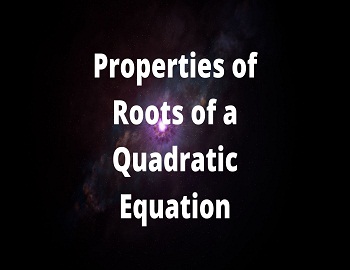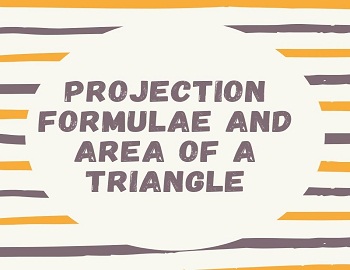Properties of Roots of a Quadratic Equation:
(1) A quadratic equation cannot have more than two roots.
Proof: If possible, let the quadratic equation ax2 + bx + c = 0, a ≠ 0 have three distinct roots, namely α, β and γ. Then, each of the three roots must satisfy the equation.
| ∴ aα2 + bα + c = 0 ……….(i) aβ2 + bβ + c = 0 ……….(ii) and aγ2 + bγ + c = 0 ……….(iii) Subtracting (ii) from (i) and (iii) from (ii), we get a(α2 – β2) + b(α – β) = 0 ……….(iv) and a(β2 – γ2) + b(β – γ) = 0 ……….(v) From (iv), a(α – β)(α + β) + b(α – β) = 0 ⇒ (α – β) {a(α + β) + b} = 0 α ≠ β, as the roots are distinct. ∴ a(α + β) + b = 0 ………(vi) Similarly, from (v), we get a(β + γ) + b = 0 ………(vii) Subtracting (vii) from (vi), we get a(α – γ) = 0 But a ≠ 0 ∴ α = γ, which contradicts our assumption that the roots are distinct. Thus, a quadratic equation cannot have more than two roots. |
(2) Irrational roots of a quadratic equation with rational coefficients occur in conjugate pair.
Proof: Let α + √β, where α and β are rational, be an irrational root of the quadratic equation ax2 + bx + c = 0, where a, b, c are rational and a ≠ 0. Then, α + √β must satisfy the equation.
| ∴ a(α + √β)2 + b(α + √β) + c = 0 ⇒ a(α2 + 2α√β + β) + bα + b√β + c= 0 ⇒ (aα2 + aβ + bα + c) + (2aα + b)√β = 0 Now, equating the rational and irrational parts separately, we get aα2 + aβ + bα + c = 0 and (2aα + b) = 0 ∴ aα2 + aβ + bα + c – (2aα + b)√β = 0 ⇒ a(α2 – 2α√β + β) + b(α – √β) + c = 0 ⇒ a(α – √β)2 + b(α – √β) + c = 0, which implies that α – √β also satisfies the quadratic equation. Thus, if α + √β is a root of the quadratic equation ax2 + bx + c = 0, where a, b, c, α and β are all rational, then α – √β must also be another root. As a quadratic equation has only two roots, α + √β and α – √β are the two roots, which occur in conjugate pair in the above case. |
(3) Imaginary roots of a quadratic equation with real coefficients must occur in conjugate pair.
Proof: Let α + iβ, with α, β as real, be an imaginary root of the quadratic equation ax2 + bx + c = 0 with a, b, c real and α ≠ 0. Then α + iβ must satisfy the quadratic equation.
| ∴ a(α + iβ)2 + b(α + iβ) + c = 0 ⇒ aα2 + 2aαβi – aβ2 + bα + bβi + c = 0 ⇒ (aα2 – aβ2 + bα + c) + (2aαβ + bβ)i = 0 Now, equating the real and imaginary parts separately, we get aα2 – aβ2 + bα + c = 0 and 2aαβ + bβ = 0 ∴ (aα2 – aβ2 + bα + c) – (2aαβ + bβ)i = 0 ⇒ a(α2 – 2αβi – β2) + b(α – iβ) + c = 0 ⇒ a(α – iβ)2 + b(α – iβ) + c = 0, which implies that α – iβ also satisfies the given equation. Thus, if α + iβ is a root of the quadratic equation with real coefficients, then α – iβ must be the other root. Hence, imaginary roots of a quadratic equation with real coefficients occur in conjugate pair. |









Comments (No)